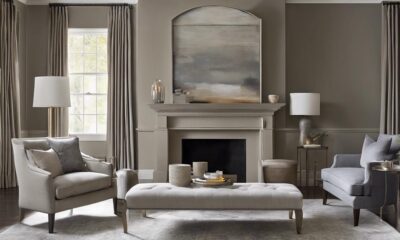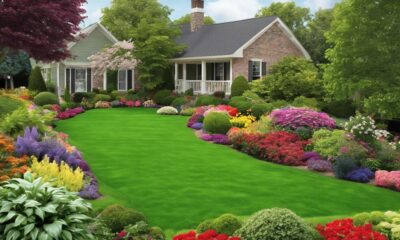Appliances
Electricity Usage of Fans: Costs & Tips Explained
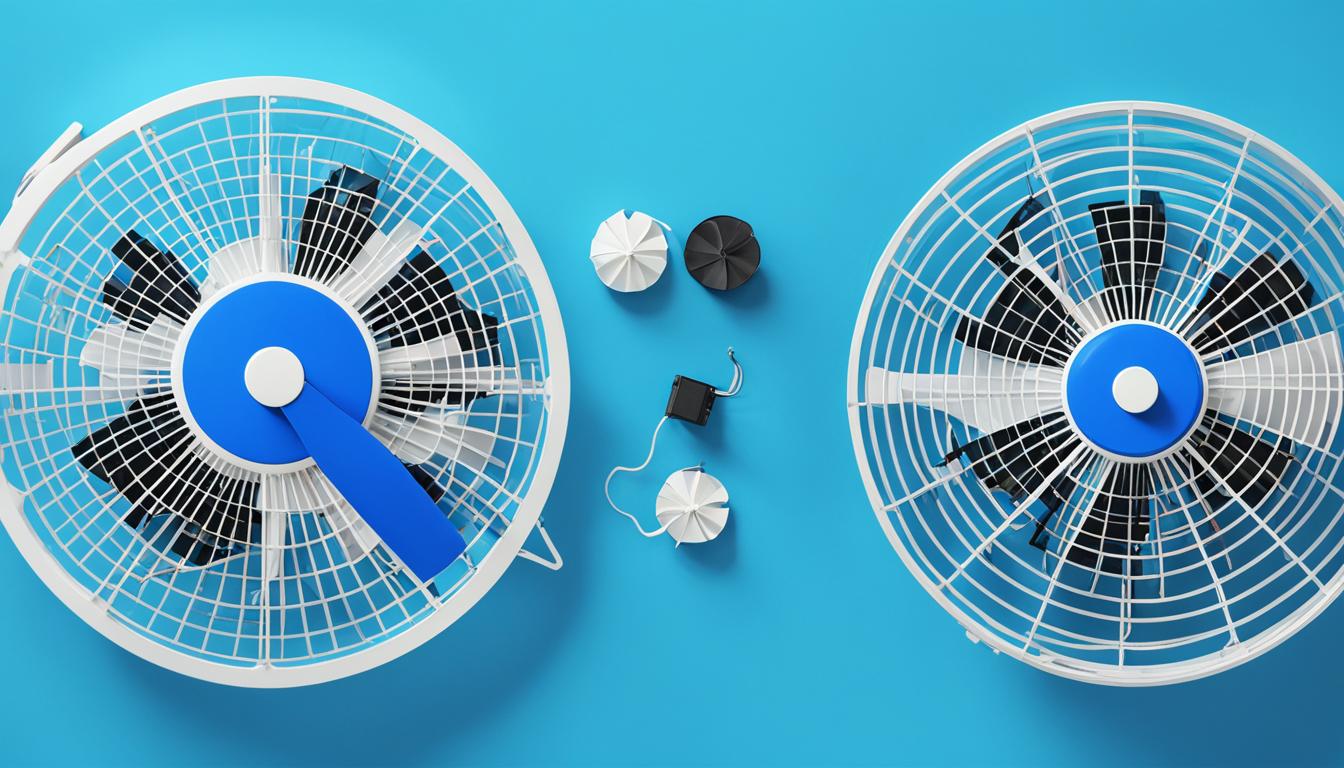
Welcome to our in-depth guide on fan electricity usage. A lot of individuals often ask, “How much electricity does a fan consume?” or “What is the energy consumption of a fan?” We are here to offer insights, analyze various fan types, their power consumption, and provide energy-saving tips.
Running a fan is a cost-effective way to stay cool during hot weather without relying heavily on air conditioners. Fans consume significantly less electricity compared to air conditioners, making them an energy-efficient cooling option.
Key Takeaways:
- Running a fan takes less electricity than running an air conditioner.
- Ceiling fans use about 15-90 watts, tower fans use about 100 watts, and whole-house fans use between 120 and 600 watts.
- Energy-efficient fans, such as ENERGY STAR® ceiling fans, can be up to 60% more energy efficient than non-certified fans.
- Smart fans have features like adjustable fan speeds and automatic shut-off, helping to save energy.
- Using fans in conjunction with air conditioners can help reduce overall energy costs.
Energy-efficient Ceiling Fans
When it comes to cooling your home efficiently, energy-efficient ceiling fans are a game-changer. These fans use less energy than traditional ceiling fans and can be up to 60 percent more energy efficient than non-certified fans. Not only do they provide a cost-effective cooling solution, but they also help reduce your carbon footprint.
The energy usage of a ceiling fan depends on its size. Let’s take a closer look at the energy consumption of different blade sizes:
| Ceiling Fan Blade Size | Energy Usage (Watts) |
|---|---|
| 36 inches | 55 watts |
| 48 inches | 75 watts |
| 52 inches | 90 watts |
ENERGY STAR® ceiling fans are a top choice for energy efficiency. These fans are approved by the US Environmental Protection Agency and are designed with motors, blade designs, and LED or CFL lighting that reduce energy consumption. By opting for an ENERGY STAR® ceiling fan, you can lower your energy usage without compromising on performance or style.
Not only are ceiling fans energy efficient, but they are also cost-effective compared to air conditioners. With a wide range of styles and sizes available, you can find the perfect ceiling fan to suit your home’s decor. Additionally, using a ceiling fan in conjunction with your air conditioner can help reduce your overall energy costs. By using the ceiling fan to circulate cool air, you can set your air conditioner to a higher temperature without sacrificing comfort.
Benefits of Energy-efficient Ceiling Fans:
- Lower energy consumption
- Reduced carbon footprint
- Cost-effective cooling solution
- Wide range of styles and sizes available
- Compatible with air conditioners for enhanced energy savings
Investing in energy-efficient ceiling fans not only helps you save on energy costs but also contributes to a more sustainable future. Choose an ENERGY STAR® certified fan that suits your home’s needs and start enjoying the benefits of energy-efficient cooling.
Energy-efficient Whole-House Fans
Whole-house fans are a larger alternative to ceiling fans, offering a more powerful cooling solution for your entire home. While they consume more power, typically between 120 and 600 watts, whole-house fans are still significantly more energy-efficient than central air conditioners. This makes them a cost-effective option for keeping your home cool during hot summer months.
One of the advantages of whole-house fans is that they provide heat relief for the entire house. By drawing in cool outdoor air and forcing out hot air through attic vents, they can quickly cool down your home, especially during the evening or early morning when outdoor temperatures are lower. This natural ventilation system helps create a comfortable living environment without relying heavily on energy-consuming air conditioning systems.
Furthermore, whole-house fans offer attic ventilation benefits. By removing hot air from the attic, they can prevent the buildup of heat and moisture, helping to maintain the integrity of your roof and prolonging its lifespan. This reduces the strain on your air conditioning system, improving its efficiency and potentially extending its lifespan as well.
Despite their energy-efficient cooling capabilities, it’s important to consider some drawbacks of whole-house fans. They can be noisy when operating at high speeds, which may impact your comfort level, especially during nighttime. Additionally, the use of whole-house fans can reduce the efficiency of your air conditioner, as the cool air brought in by the fan is often quickly dispersed throughout the house. This means your air conditioner may need to work harder to maintain the desired temperature.
Professional installation is typically required for whole-house fans to ensure proper performance and ventilation. They also need proper ventilation pathways to avoid pulling in combustion materials, such as gases from water heaters or furnaces. It’s crucial to consult a qualified technician to assess your home’s specific requirements and ensure safe and efficient use of a whole-house fan.

Energy-efficient Window Fans
Window fans are a great energy-efficient cooling option for homes. These fans are specifically designed to be installed in open windows to help move air in and out of the house, providing a refreshing breeze. They consume significantly less energy compared to air conditioners, making them a more environmentally friendly choice.
Window fans typically have an energy usage range of 35 to 100 watts, depending on the model and speed settings. This lower energy consumption translates to cost savings on your electricity bill.
One of the key advantages of window fans is their affordability. They are generally less expensive than other types of fans, making them a budget-friendly cooling solution for homeowners.
Window fans can also draw in fresh outside air, improving indoor air quality and ventilation. This can be especially beneficial if you live in an area with clean and cool outdoor air.
Installation and removal of window fans are relatively straightforward. You can easily install them by securing them in the designated window opening. This allows you to take advantage of the cool outdoor breeze without the need for complex installation procedures.
In larger homes, using multiple window fans strategically placed throughout the house can effectively cool the entire home. This versatility makes window fans an excellent choice for households looking for an affordable and energy-efficient cooling solution.
However, it’s important to note that window fans are not ideal for every home. To maximize their efficiency, proper blocking of air cavities is required to prevent outside air from entering unwanted spaces. This ensures that the cooling effect is concentrated only in the desired areas of the house.
Key Advantages of Energy-efficient Window Fans:
- Budget-friendly cooling option
- Lower energy consumption compared to air conditioners
- Improved indoor air quality and ventilation
- Easy installation and removal
- Versatile cooling solution for entire homes
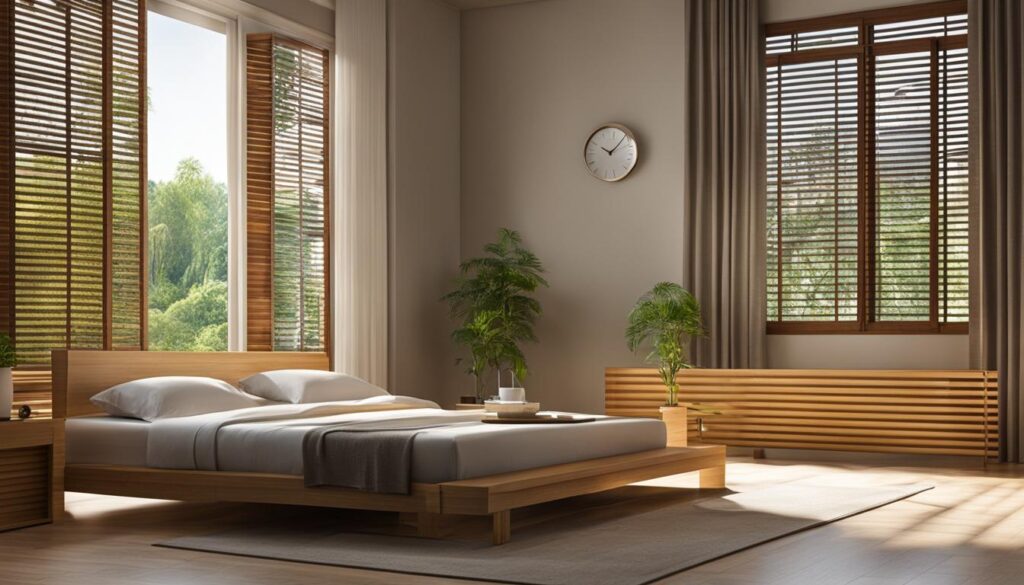
Window fans offer a cost-effective and energy-efficient way to cool your home. By harnessing the natural outdoor breeze, these fans can provide comfort while minimizing your energy usage. Consider incorporating window fans into your cooling strategy to save money and reduce your environmental impact.
Energy-efficient Tower Fans
Tower fans are a popular choice for cooling homes due to their portability, versatility, and energy efficiency. These vertical fans are designed to move air already present in the house, providing a refreshing breeze in any room. Tower fans typically consume between 48 to 100 watts of energy, making them an energy-efficient cooling option.
One of the key advantages of tower fans is their multiple speed settings, allowing users to adjust the airflow to their preference. Whether you need a gentle breeze or a more powerful airflow, tower fans can accommodate your needs. They also come in a variety of colors and styles to suit any room decor.
Additionally, tower fans are known for their affordability compared to other cooling options. They are usually more cost-effective to purchase and operate than air conditioners, making them a budget-friendly choice.
One crucial factor to consider when using tower fans is their limited range for air movement. Unlike ceiling fans or whole-house fans, tower fans have a smaller reach. This means that they are best suited for cooling individual rooms rather than large spaces. However, they can be easily moved between rooms, providing cooling wherever you need it.
It’s important to note that tower fans tend to accumulate dust and dander over time. Regular cleaning and maintenance are necessary to ensure optimal performance and prevent the circulation of allergens in the air. Nevertheless, with proper care, tower fans can effectively improve indoor air circulation and provide a comfortable environment.
“Tower fans are portable, energy-efficient, and offer multiple speed settings for personalized comfort.” – HVAC Expert
Benefits of Energy-efficient Tower Fans:
- Portability: Easily move the fan between rooms for targeted cooling.
- Versatility: Multiple speed settings accommodate different airflow preferences.
- Affordability: Cost-effective option compared to air conditioners.
- Improves air circulation: Helps to reduce stuffiness and improve indoor air quality.
When choosing a tower fan, consider the size and layout of your space, as well as your specific cooling needs. Whether you need a compact fan for a small bedroom or a more powerful model for a larger living area, energy-efficient tower fans offer a range of options to suit your requirements.
Smart Fans
Smart fans offer a range of advantages over traditional fans, including enhanced energy efficiency and convenient control options. These innovative devices are designed to adapt to your cooling needs, allowing you to save energy and reduce costs. By automatically adjusting fan speed based on room temperature or occupancy, smart fans optimize energy usage and provide efficient cooling. According to data from the US General Services Administration, they can reduce energy costs by 4 to 11 percent.
One of the key advantages of smart fans is their highly energy-efficient operation. By intelligently adjusting fan speed, these fans consume only the necessary amount of energy to maintain a comfortable indoor environment. This not only helps to save on electricity bills but also reduces environmental impact. With their advanced programming capabilities, smart fans can be customized to fit your specific cooling requirements, ensuring optimal comfort while minimizing energy consumption.
Controlling smart fans is incredibly easy thanks to their compatibility with smartphone apps. You can control the fan’s settings, such as speed and timer, directly from your phone, providing convenient access to personalized cooling solutions. Additionally, smart fans can be integrated with other smart home devices, allowing you to create a seamless and automated cooling system.
When it comes to installation, it’s important to note that smart fans may require additional steps compared to traditional ceiling fans. Their advanced features and connectivity options may require setting up a Wi-Fi connection and configuring the fan using a smartphone app. While this may take a bit more effort during the installation process, the long-term benefits of smart fans in terms of energy savings and convenience make it worthwhile.
Overall, smart fans offer a smart and energy-efficient cooling solution for your home. With their ability to adapt to room conditions, their customizable settings, and their integration into your smart home ecosystem, these fans provide a modern and efficient way to stay cool. While they may come at a slightly higher initial cost compared to traditional fans, the long-term savings and convenience they offer make them a worthwhile investment.
How to Use a Smart Fan
Using a smart fan is not only convenient but also energy-efficient. By following a few tips and properly installing your smart fan, you can maximize its benefits and improve your home’s cooling efficiency.
Smart Fan Installation
Installing a smart fan is similar to installing a traditional ceiling fan. Here are the steps to ensure a successful installation:
- Turn off the power supply to the fan at the circuit breaker.
- Remove the existing fan, if applicable.
- Follow the manufacturer’s instructions to install the smart fan, making sure to securely mount it to the ceiling using the provided hardware.
- Connect the wiring according to the wiring diagram, ensuring proper grounding.
- Attach the fan blades and any additional accessories.
- Turn on the power supply at the circuit breaker and test the smart fan’s functionality.
Smart Fan Tips
Once your smart fan is installed, here are some tips on how to make the most of its features:
- Use smart assistants or hubs: Connect your smart fan to platforms like Alexa, Google Assistant, or Apple HomeKit to control it using voice commands or automate its operation.
- Link with other smart devices: Integrate your smart fan with other smart devices in your home, such as thermostats or air conditioners. This allows you to create custom cooling routines or synchronize the fan’s operation with the temperature settings.
- Utilize smartphone apps: Download the manufacturer’s app to control your smart fan remotely. Adjust fan speed, set timers, and monitor room temperature and occupancy rates right from your smartphone.
- Optimize occupancy sensors: If your smart fan has built-in occupancy sensors, configure them to automatically turn on or off based on room occupancy. This ensures the fan operates only when needed, saving energy.
“By utilizing the smart features of your fan, you can customize its operation, reduce energy consumption, and enhance your home’s comfort.”
| Advantages of Using a Smart Fan | How to Use a Smart Fan |
|---|---|
| Energy-efficient cooling | Install the smart fan according to manufacturer’s instructions |
| Convenient control through smart assistants or smartphone apps | Connect the smart fan to smart assistants or hubs |
| Integration with other smart devices in your home | Link the smart fan with other smart devices |
| Automatic operation based on room occupancy | Optimize occupancy sensors |
Cost of Running Different Types of Fans
When considering the cost of running different types of fans, two factors come into play: the wattage of the fan and the rate you pay for electricity. Understanding these factors can help you make informed decisions about the most cost-effective cooling options for your home.
According to data from Canstar Blue, here’s an overview of the running costs for various types of fans:
| Fan Type | Running Cost per Hour |
|---|---|
| Pedestal Fan | Between 1.15c and 2.30c |
| Tower Fan | Up to 3.28c |
| Desk Fan | Less than one cent |
These figures provide a general idea of the hourly running costs for each type of fan. However, it’s important to note that annual running costs can vary significantly based on usage patterns and assumptions.
Keep in mind that these running costs are estimates, and actual costs may vary depending on factors such as fan efficiency and local electricity rates. Nevertheless, understanding the approximate running costs can help you compare different fan options and make an informed decision based on your budget and energy consumption goals.
By knowing the cost of running fans, you can choose the most economical option for your cooling needs. Whether you opt for a pedestal fan, a tower fan, or a desk fan, understanding the running costs can help you manage your electricity expenses more efficiently.
Conclusion
Fans are a more energy-efficient cooling option compared to air conditioners. Whether you choose a ceiling fan, whole-house fan, window fan, tower fan, or smart fan, each has its own unique energy usage levels. By opting for energy-efficient fans, you can not only lower your energy costs but also enjoy effective heat relief.
When using fans, it’s important to consider factors such as fan size and speed settings. Ceiling fans, for example, come in different blade sizes and consume varying levels of energy, ranging from approximately 55 to 90 watts. Whole-house fans, on the other hand, are larger and consume more power, typically between 120 and 600 watts. Window fans consume between 35 and 100 watts, while tower fans use an average of 48 to 100 watts.
To maximize energy savings, consider combining fans with energy-efficient air conditioners, especially during extremely hot days. This combination can help regulate room temperature and reduce overall energy consumption. By using fans properly and making informed choices about the type of fan and settings, you can enhance your cooling experience while minimizing energy usage.
So, whether you’re a fan of ceiling fans, whole-house fans, window fans, tower fans, or smart fans, keep in mind that utilizing these energy-saving alternatives can be a win-win. Stay cool, save energy, and enjoy the benefits of a more sustainable and cost-effective cooling solution!
FAQ
How much electricity does a fan use?
The electricity usage of a fan depends on its type. Ceiling fans typically use between 15 to 90 watts, tower fans use around 100 watts, window fans consume between 35 to 100 watts, and whole-house fans consume between 120 to 600 watts.
Are energy-efficient ceiling fans worth it?
Yes, energy-efficient ceiling fans are worth it. They can be up to 60% more energy efficient than non-certified fans. The energy usage of a ceiling fan depends on its size, ranging from approximately 55 to 90 watts. ENERGY STAR® ceiling fans are approved by the US Environmental Protection Agency and can help reduce energy costs.
What are the advantages of whole-house fans?
Whole-house fans are a more energy-efficient cooling option compared to central air conditioners. They provide heat relief for the entire house, offer attic ventilation, and consume less power, typically between 120 to 600 watts.
How much energy do window fans consume?
Window fans are a cost-effective cooling option and typically consume between 35 to 100 watts. They can draw in fresh air from outside and are easy to install and uninstall.
What is the energy usage of tower fans?
Tower fans use between 48 to 100 watts on average. They are portable, come in a variety of styles, and are suitable for moving air already in the house.
What are smart fans?
Smart fans are energy-efficient fans that can be programmed to turn on and off based on room temperature or occupancy. They can reduce energy costs and can be controlled through phone apps and connected to other smart home devices.
How do I use a smart fan?
To use a smart fan, you can control its settings through a smartphone app. You can set it to turn on when you enter a room or link it to your air conditioner or thermostat. Smart fans can also track temperature and occupancy rates of rooms.
How much does it cost to run different types of fans?
The cost of running a fan depends on its wattage and the rate you pay for electricity. On average, a pedestal fan can cost between 1.15c to 2.30c per hour, a tower fan can cost up to 3.28c per hour, and a desk fan can cost less than one cent per hour.
Are fans more energy-efficient than air conditioners?
Yes, fans are more energy-efficient compared to air conditioners. Using fans, such as ceiling fans, in combination with energy-efficient air conditioners can help regulate room temperature and reduce overall energy consumption.
What are some energy-saving tips for using fans?
To save energy when using fans, consider choosing energy-efficient fan models, adjust fan speed accordingly, and turn off fans in unoccupied rooms. Combining fans with other energy-saving measures, such as proper insulation and sealing of windows and doors, can also help maximize energy efficiency.
Source Links
- https://blog.constellation.com/2018/05/10/energy-efficient-fans/
- https://www.canstarblue.com.au/electricity/portable-fans-running-costs/
- https://news.sky.com/story/beating-the-heat-how-much-does-it-cost-to-use-an-electric-fan-12655095
- About the Author
- Latest Posts
Meet Bethia, the visionary designer at ByRetreat who brings a touch of magic to every remote workspace she creates. With a boundless imagination and an eye for beauty, Bethia is passionate about transforming ordinary spaces into extraordinary havens of creativity and comfort.
Bethia possesses a unique talent for envisioning the perfect combination of furniture, colors, and textures that harmonize seamlessly in a room. She understands that selecting furniture goes beyond mere functionality; it’s about curating pieces that evoke a sense of style and sophistication while enhancing the overall ambiance.
Garage Door Opener
10 Steps to Install Your Liftmaster Garage Door Opener
Hone your installation skills with 10 essential steps to set up your Liftmaster opener, unlocking a world of convenience and security.

Let’s simplify the installation process of your Liftmaster garage door opener step by step, just like untangling a knot to find a tidy solution.
From gathering the necessary tools to enjoying the convenience of a smoothly functioning opener, each stage plays a crucial role in ensuring a successful installation.
As we embark on this journey of assembling and setting up your Liftmaster opener, you'll find that each step builds upon the previous one, offering a sense of accomplishment and security.
So, let's begin this transformative journey together towards a more convenient and secure garage door experience.
Key Takeaways
- Gather necessary tools and follow manufacturer's instructions for proper installation.
- Install components securely and align properly for smooth operation.
- Program opener settings accurately for efficient use.
- Test functionality and ensure safety features are working correctly.
Gather Necessary Tools
We'll need to gather the necessary tools before proceeding with the installation of your Liftmaster garage door opener. To ensure a smooth installation process, it's crucial to have the following tools ready:
- a power drill
- a level
- adjustable wrenches
- a hammer
- screwdrivers
- locking pliers
- a ladder
- safety glasses
- a tape measure
These tools are essential for mounting the opener, adjusting the tracks, and securing all components properly.
Additionally, make sure to have your cell phone and Wi-Fi password handy for the setup process. This will enable you to connect your garage door opener to your smartphone for convenient operation. Having the dealer external ID ready for digital sticker activation is also important for ensuring smooth functionality.
Measure and Mark for Installation
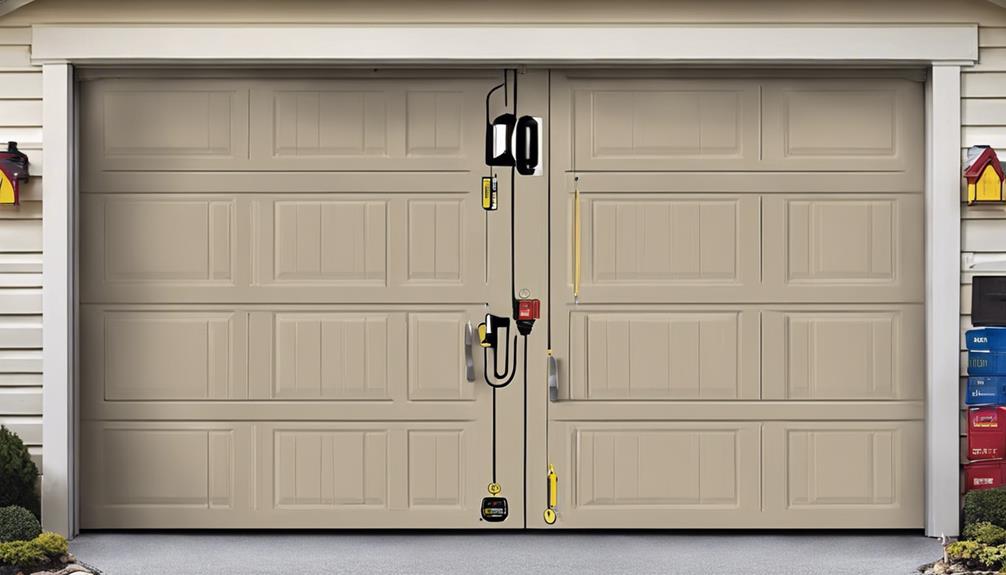
Before commencing the installation process, accurately measure and mark the designated areas following the manufacturer's guidelines for optimal positioning of the Liftmaster garage door opener. Ensuring precise measurements and markings is crucial for a successful installation.
Here are key steps to follow:
- Measure the height of your garage door: Compatibility with the opener is essential for seamless operation.
- Check the balance of your garage door: This step is vital to prevent any issues during and after the installation process.
- Mark the location for mounting the motor unit: Following the manufacturer's guidelines will help in determining the best placement for efficient functioning.
Identifying any reinforcements needed and using a level to guarantee accurate markings will set the foundation for a smooth installation of your Liftmaster garage door opener. By meticulously measuring and marking the installation areas, you pave the way for a trouble-free setup process.
Attach Mounting Bracket
To securely affix the garage door opener motor unit to the ceiling, the mounting bracket must be attached following the manufacturer's precise instructions. The mounting bracket is a crucial component that provides stability and support for the garage opener during its operation. It's imperative to install the bracket correctly to ensure the safe and efficient functioning of the garage door opener. By securely attaching the mounting bracket, you guarantee that the opener remains in place and operates smoothly.
When attaching the mounting bracket, make sure to follow the detailed guidelines provided by the manufacturer. Use the appropriate tools and hardware included in the garage opener package to affix the bracket securely to the ceiling. The mounting bracket's role in the installation process of the Liftmaster garage door opener can't be overstated, as it's the foundation on which the entire system operates. Proper installation of the mounting bracket is essential for the successful operation of your garage door opener.
Install the Rail and Trolley
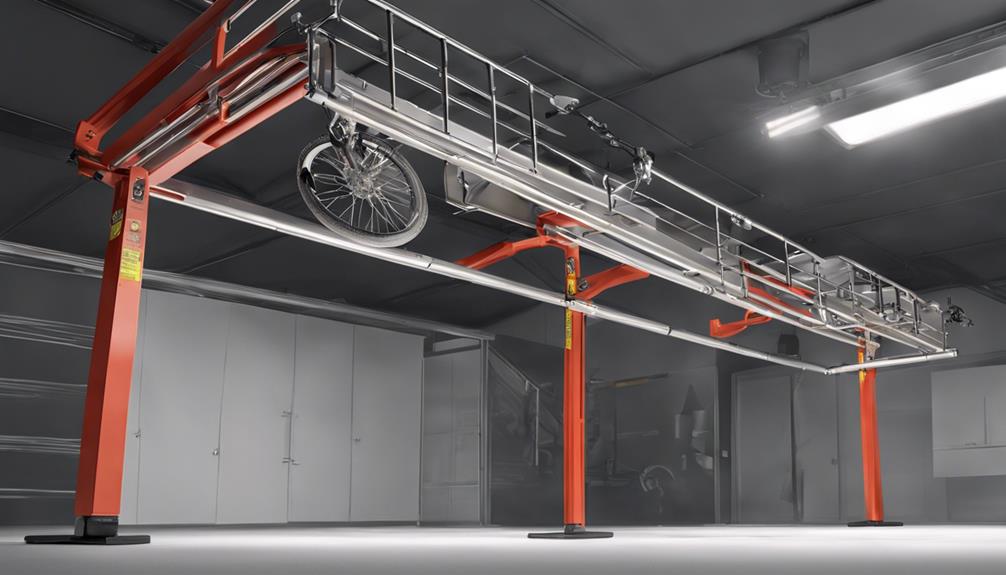
Let's ensure a sturdy installation by securely mounting the rail and attaching the trolley according to the manufacturer's instructions. Proper alignment of the rail is key for the smooth movement of the trolley along the track, facilitating the garage door's operation.
Mount the Rail Securely
Securing the rail to the motor unit with lag screws is crucial for ensuring the stability of your Liftmaster garage door opener installation. Here are some key steps to mount the rail securely:
- Use lag screws to attach the rail to the motor unit firmly.
- Align the rail assembly properly to guarantee smooth garage door opener operation.
- Ensure the rail is level and straight to avoid any operational issues.
Attach Trolley to Rail
After securely mounting the rail to the motor unit, the next crucial step in installing your Liftmaster garage door opener is attaching the trolley to the rail. To do this, slide the trolley onto the rail and secure it using the provided hardware.
Ensure the trolley moves smoothly along the rail without any obstructions. Connect the trolley to the traveler on the garage door using the attachment hardware provided.
Adjust the trolley's position on the rail to align it with the garage door opener motor unit. It's essential to securely attach the trolley to the rail to guarantee the smooth operation of your garage door opener.
This step is vital for the overall functionality and performance of your garage door opener system.
Connect the Drive System

Let's focus on the crucial step of connecting the drive system components, ensuring a secure attachment of the rail to the motor unit. Proper alignment and connection are essential for the smooth operation of the garage door opener.
Following the manufacturer's instructions meticulously is key to achieving optimal performance.
Drive System Components
To properly connect the drive system components in your Liftmaster garage door opener, begin by unpacking the rail assembly and securely attaching it to the motor unit. The drive system components include the motor unit, rail assembly, sprocket cover, and necessary accessories.
Here are key steps to follow:
- Ensure the sprocket cover is installed correctly to protect the drive system components.
- Properly mount the motor unit for smooth operation.
- Connect the rail to the header bracket and install the support bracket for a well-functioning belt drive garage setup.
Following these steps meticulously will ensure the effective functioning of your Liftmaster garage door opener's drive system.
Connecting Power Source
Having properly connected the drive system components in your Liftmaster garage door opener, the next crucial step is to securely connect the power source to ensure seamless operation.
The power source for your garage door opener is typically a standard electrical outlet. To connect the power source, plug the power cord of the opener into the nearest electrical outlet. Ensure that the connection is secure to prevent any disruptions during operation.
The drive system, including the motor unit and rail assembly, relies on the power from this outlet to open and close the garage door effectively. Properly connecting the power source is essential for the overall functionality of your Liftmaster garage door opener.
Securing Drive Assembly
We securely attach the drive assembly by fastening the rail to the motor unit using the provided hardware. It's crucial to ensure proper alignment and connection of the drive system components for smooth operation. Follow the manufacturer's instructions diligently to secure the drive assembly and prevent any operational issues.
To guarantee a stable installation, check and tighten all fasteners meticulously. Remember, properly securing the drive system is essential for the safe and reliable operation of your garage door opener. In case of emergencies, familiarize yourself with the emergency release procedure provided by the manufacturer.
Your attention to detail during this step will contribute to the overall efficiency and safety of your garage door opener.
- Ensure proper alignment and connection of drive system components.
- Follow manufacturer's instructions for securing the drive assembly.
- Familiarize yourself with the emergency release procedure.
Adjust the Opener Settings

When adjusting the opener settings on your Liftmaster garage door opener, make sure to carefully adjust the travel limits for the door's up and down positions as needed. Utilize the programming buttons located near the wiring connectors for precise adjustments.
For newer opener models, follow the step saver setup label instructions to streamline the process.
After making adjustments, it's crucial to test the travel limits to ensure the door operates smoothly and efficiently. Regularly checking and fine-tuning the travel limits is essential for the optimal performance of your garage door opener.
Remember to also consider the battery backup feature, ensuring it's functioning correctly to provide peace of mind during power outages. By paying attention to these details and following the manufacturer's guidelines, you can customize your Liftmaster garage door opener to meet your specific needs and preferences, allowing for a seamless and reliable operation.
Program the Remote Control
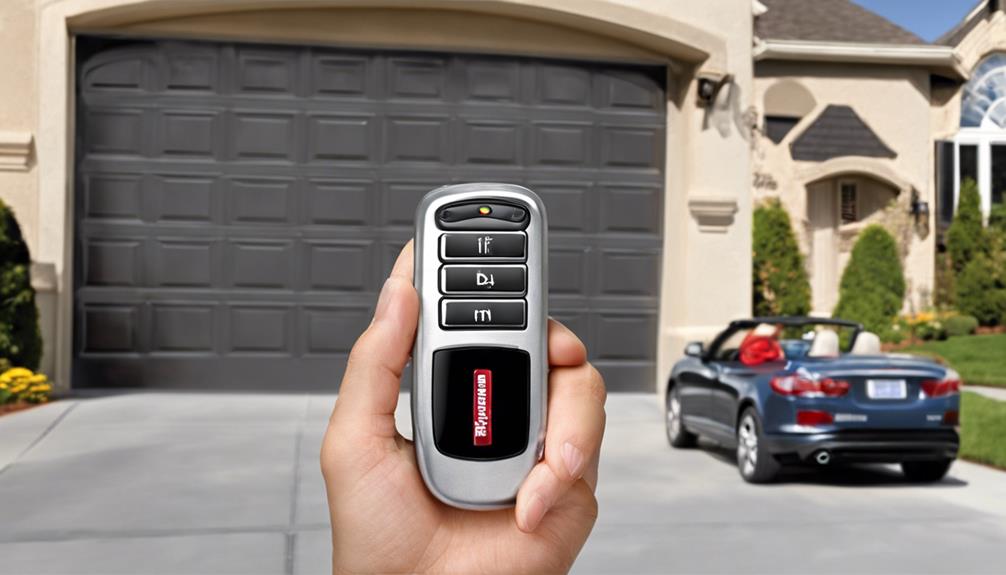
To efficiently program the remote control for your Liftmaster garage door opener, begin by locating the 'Learn' button situated on the motor unit. Once you've found the button, follow these steps:
- Press and release the 'Learn' button on the motor unit.
- Next, press and hold the button on the remote control you wish to program.
- Wait for the motor unit lights to flash, indicating that the programming was successful.
Test the Garage Door Opener
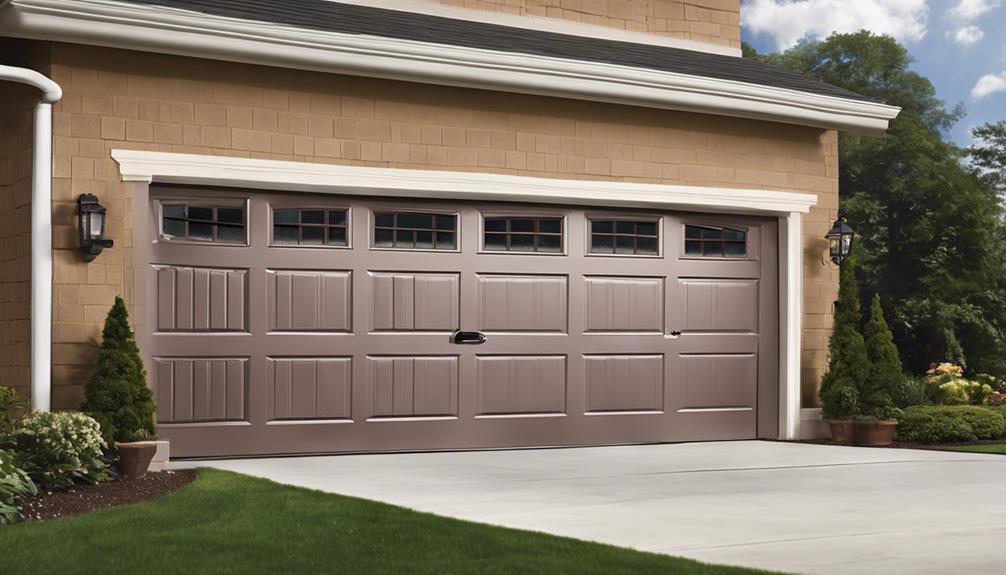
Let's ensure the garage door opener functions smoothly by testing its remote operation.
We'll check for any unusual noises or jerking movements during the door's movement.
Ensuring proper sensor alignment is crucial for the opener's safety features to work effectively.
Opener Functionality Check
Upon pressing the remote control button, test the garage door opener's functionality by smoothly opening and closing the door to ensure optimal operation.
- Observe the door's movement for any jerks or hesitations that could indicate issues.
- Listen for consistent motor sounds during both opening and closing cycles.
- Confirm that the door fully closes and the safety reversal system engages correctly.
Sensor Alignment Verification
After ensuring the opener's functionality, the next crucial step is to verify the alignment of the sensors by performing a test with an object placed in the door's path.
To conduct this test, place an object at least 12 inches high in the access to the garage. Test the garage door opener by initiating a close command. The safety reversal system should promptly detect the obstruction and halt the door's movement. Verify that the door smoothly reverses without any hesitations or issues.
Regularly testing the safety reversal system is vital to uphold its proper functionality, ensuring the safety of individuals and objects in the garage. This step guarantees that the sensors are accurately aligned and operational for secure garage door operation.
Secure All Components
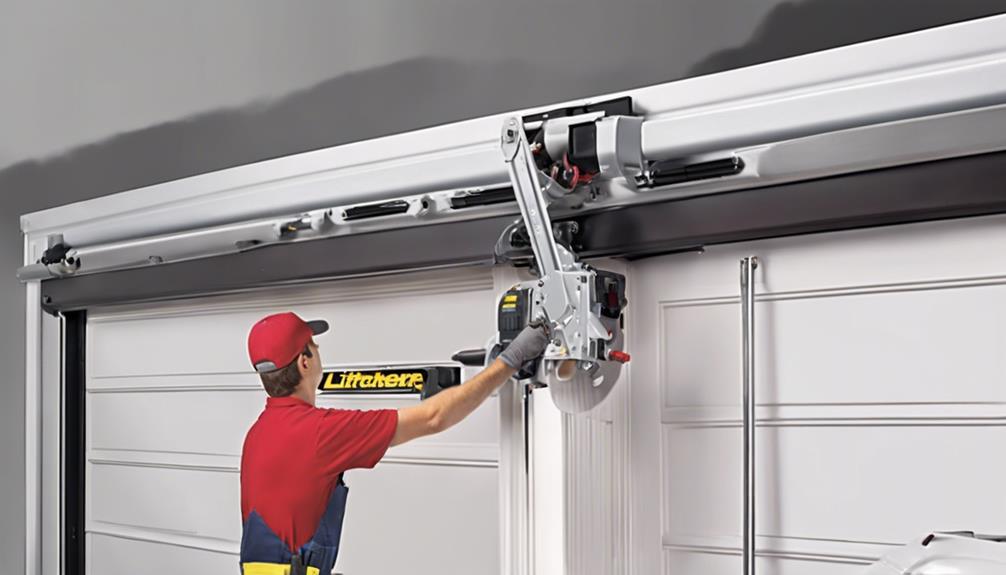
To ensure optimal performance and safety, it's crucial to securely fasten and align all components of your Liftmaster garage door opener. When installing your opener, here are some key steps to secure all components effectively:
- Mount the motor unit securely: Ensure the motor unit is firmly mounted to prevent unnecessary vibrations during the operation of the garage door.
- Attach the rail assembly properly: The rail assembly must be securely attached to the motor unit to provide adequate support for the weight of the garage door.
- Install the sprocket cover securely: The sprocket cover should be securely installed to protect the moving parts and promote safe operation of the garage door opener.
Enjoy Your Newly Installed Liftmaster Opener
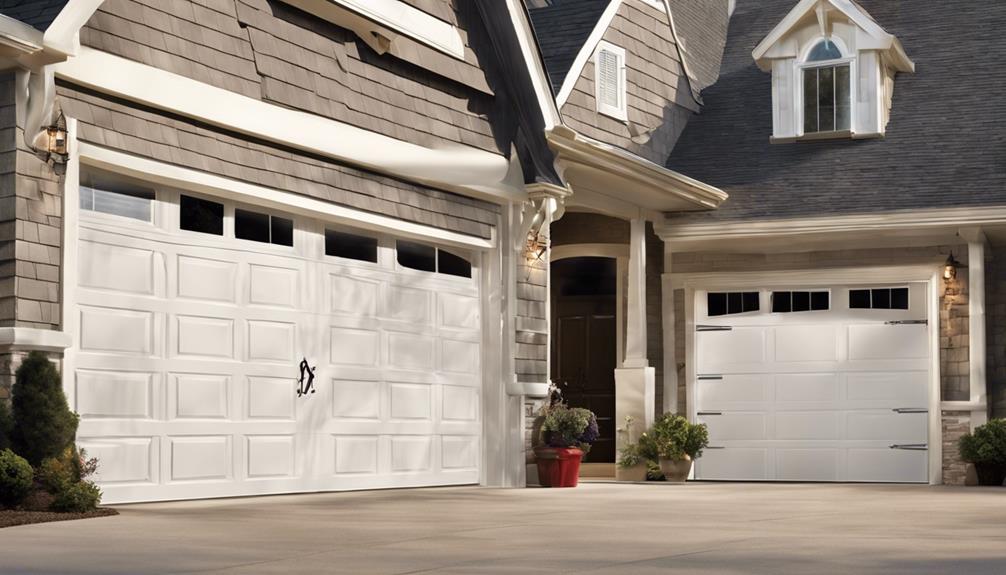
Let's make sure your newly installed Liftmaster opener is fully operational before enjoying its advanced features. To ensure everything is set up correctly, first, confirm that the garage door opens and closes smoothly when using the remote or wall control.
Check the safety features by placing an object in the door's path to verify that the safety sensors are working correctly, causing the door to reverse when obstructed.
Next, explore the MyQ app on your smartphone to control the opener remotely. Experiment with the Secure View camera feature for added security, allowing you to monitor your garage from anywhere. Enable notifications and alerts to stay informed about your garage door's activity in real-time. Share access with family members or trusted individuals through the MyQ app effortlessly.
Lastly, keep in touch with your dealer for any support or service needs by utilizing the digital sticker feature. Now that everything is in place, enjoy the convenience and peace of mind your Liftmaster opener brings to your daily routine.
Frequently Asked Questions
How Do You Set up a Liftmaster Garage Door Opener?
Setting up a Liftmaster garage door opener involves mounting the motor unit, connecting the rail, installing brackets, and ensuring safety measures are in place.
After programming buttons and installing safety sensors, follow guidelines for sensor installation, door control, travel limits programming, and battery setup.
Remember to locate the MyQ serial and model numbers for future reference. Our experience tells us that proper installation is key to a functional and secure garage door opener system.
How Long Does It Take to Install a Liftmaster Garage Door Opener?
Installing a Liftmaster garage door opener typically takes 2 to 4 hours, with professionals sometimes finishing in just 1 to 2 hours. Factors like your garage door type and existing wiring can impact the time needed.
Following detailed instructions helps streamline the process. It's wise to set aside a morning or afternoon for thorough setup and testing. Our experience shows these steps ensure a successful installation.
How Do I Prepare My Garage Door Opener for Installation?
Before starting the installation of your Liftmaster garage door opener, we recommend preparing the area by ensuring the homeowner has their cell phone, Wi-Fi password, and dealer's external ID for the digital sticker.
Measure the garage door height, check for reinforcements, and verify the door's balance.
Unpack and assemble the motor unit, accessories, and rail components. Confirm all necessary parts are included and ready for assembly to streamline the installation process.
Can I Install a Garage Door Opener Myself?
Yes, we can install a garage door opener ourselves. It's a cost-effective option that can be achieved with basic tools and careful adherence to safety guidelines.
Following manufacturer instructions and seeking professional help when needed ensures a successful installation.
DIY projects like this empower us to take control of our home improvement needs while saving money and gaining valuable skills.
Conclusion
Now that the Liftmaster garage door opener is installed and ready to go, it's time to see it in action. Press the button, watch the door smoothly glide open, and marvel at the convenience and security it provides.
But wait, there's more to discover with additional features and customization options. Stay tuned for our next article where we delve deeper into maximizing the potential of your Liftmaster opener.
- About the Author
- Latest Posts
Introducing Ron, the home decor aficionado at ByRetreat, whose passion for creating beautiful and inviting spaces is at the heart of his work. With his deep knowledge of home decor and his innate sense of style, Ron brings a wealth of expertise and a keen eye for detail to the ByRetreat team.
Ron’s love for home decor goes beyond aesthetics; he understands that our surroundings play a significant role in our overall well-being and productivity. With this in mind, Ron is dedicated to transforming remote workspaces into havens of comfort, functionality, and beauty.
Garage Door Opener
What Makes the Craftsman Garage Door Opener Stand Out?
Outstanding performance and innovative features make the Craftsman Garage Door Opener a top choice for homeowners seeking reliability and convenience – but what sets it apart?

Craftsman Garage Door Openers, including models such as the Craftsman DieHard series, are known for their outstanding performance and reliability in the industry. Their reputation is based on high-quality materials and cutting-edge technology. What really makes them unique is the seamless incorporation of user-friendly features and advanced security measures.
But what truly makes the Craftsman Garage Door Opener extraordinary? Let's explore the details that make it a standout choice for homeowners seeking quality and convenience in their garage door openers.
Key Takeaways
- Renowned safety features and advanced security technology ensure top-notch protection for your garage.
- Smartphone control and innovative myQ App provide convenient operation from anywhere.
- Exceptional durability and energy-saving features make it a reliable and cost-effective choice.
- Superior performance, lifetime warranty, and smooth, quiet operation set Craftsman apart in the industry.
Craftsman Garage Door Opener Overview
Craftsman Garage Door Openers, renowned for their cutting-edge safety features, are a top choice for homeowners seeking reliable and secure access to their garages. One standout feature of Craftsman Garage Door Openers is their smartphone control capability. Through Wi-Fi connectivity and the myQ App, users can conveniently operate their garage doors remotely, adding a layer of convenience and control to their daily routine. This feature allows users to monitor and control their garage door opener from anywhere, providing peace of mind and flexibility.
Craftsman Garage Door Openers also come equipped with a multi-function wall control that offers an intuitive interface for easy operation. This control panel simplifies the process of opening and closing the garage door, enhancing user experience. Additionally, the Security+2.0® technology integrated into Craftsman Garage Door Openers ensures enhanced security, protecting against potential intruders.
In terms of visibility and safety, Craftsman Garage Door Openers feature powerful LED lights that illuminate the garage space, making it easier and safer to navigate in low-light conditions. These innovative features collectively position Craftsman Garage Door Openers as a reliable and advanced choice for homeowners looking to upgrade their garage access system.
Superior Performance and Reliability

Craftsman Garage Door Openers excel in durability and efficiency, boasting a robust 1.25 horsepower AC motor for superior lifting power.
With a reputation for reliability, Craftsman's use of top-grade materials ensures consistent performance over time.
As a trusted brand, Craftsman Garage Door Openers offer advanced safety features and a lifetime warranty on essential components, providing customers with peace of mind and quality assurance.
Durability and Efficiency
Crafted with top-grade materials and featuring a high-quality construction, the durability and efficiency of Craftsman Garage Door Openers set a benchmark for superior performance and reliability. The belt drive mechanism in Craftsman Openers ensures smooth and silent operation, making them ideal for attached garages where noise reduction is crucial. This belt drive not only enhances the overall efficiency of the opener but also contributes to its longevity by reducing wear and tear on the system. Combined with a powerful 1.25 horsepower AC motor, Craftsman Garage Door Openers deliver exceptional lift power for reliable performance. The lifetime warranty on motor and drive components further underscores the durability and efficiency that Craftsman is known for.
| Durability & Efficiency | Craftsman Garage Door Openers |
|---|---|
| Material | Top-grade |
| Construction | High-quality |
| Mechanism | Belt Drive |
Trusted Brand Reputation
With a well-established track record of superior performance and reliability, Craftsman garage door openers have garnered a trusted brand reputation in the industry.
Craftsman's commitment to quality materials and craftsmanship ensures that their garage door openers provide reliable operation over time. The brand's dedication to excellence extends to the safety features incorporated into their openers, giving customers peace of mind.
Crafted with precision and attention to detail, Craftsman garage door openers offer advanced control options for seamless operation. Customers rely on Craftsman for top-notch products that deliver on performance, durability, and safety.
When it comes to trusted brand reputation in the garage door opener market, Craftsman stands out as a leader in innovation and reliability.
Innovative Technology Integration
By integrating cutting-edge technology such as the myQ App for smartphone control, Craftsman Garage Door Openers exemplify a seamless blend of innovation and functionality. The myQ technology allows users to monitor and control their garage door opener remotely, providing convenience and peace of mind. Additionally, the Safety Reversing Sensors incorporated in Craftsman opener models enhance safety by detecting obstacles in the door's path and reversing its operation to prevent accidents.
Craftsman Garage Door Openers also feature multi-function wall controls, offering users an intuitive and straightforward way to operate their garage doors. The Security+2.0® technology further fortifies the opener's security features, ensuring that your garage and home stay protected at all times. Moreover, the powerful LED lights integrated into the openers illuminate the garage space effectively, enhancing visibility and safety.
Craftsman's commitment to integrating innovative technologies like myQ App and Safety Reversing Sensors sets their garage door openers apart, catering to users who value advanced functionalities and seamless operation.
User-Friendly Features and Design

Featuring intuitive interfaces and responsive mechanisms, Craftsman Garage Door Openers prioritize user-friendly operation and seamless design integration. The user-friendly features of Craftsman Openers cater to a wide range of users, ensuring effortless operation for everyone.
With a seamless remote control system, opening and closing your garage door becomes a simple task with just the push of a button. Additionally, the backup battery functionality of Craftsman Openers guarantees continuous operation even during power outages, providing peace of mind knowing your garage door will still function when needed most.
The integration of safety sensors further enhances the user experience by prioritizing accident prevention and user safety. Moreover, the WiFi-enabled capabilities of Craftsman Openers allow for smartphone control, adding convenience and accessibility to your garage door operation.
Craftsman Garage Door Openers are designed with user convenience and ease of use in mind, setting them apart with their user-friendly features and thoughtful design elements.
Enhanced Security Measures

Craftsman Garage Door Openers are equipped with Security+2.0® technology, offering advanced security measures such as secure access control and anti-burglary features. Safety Reversing Sensors further enhance protection, prioritizing user safety and preventing unauthorized entry.
Craftsman Garage Door Openers stand out for their robust security capabilities, providing users with peace of mind and reliable security solutions.
Secure Access Control
Enhanced security measures in Craftsman Garage Door Openers encompass cutting-edge Security+2.0® technology. This innovative system offers advanced features for secure access control, ensuring the safety of your property.
Here are four key aspects highlighting the secure access control capabilities:
- Rolling Code Encryption: Security+2.0® technology provides rolling code encryption, preventing unauthorized access and enhancing security.
- Smartphone Control: With Wi-Fi connectivity and the myQ App, users can securely control their garage door opener from anywhere using their smartphones.
- Safety Reversing Sensors: Craftsman Openers include Safety Reversing Sensors to ensure safe operation and protect against accidents.
- Advanced Security Features: Craftsman prioritizes safety and security with cutting-edge features like Security+2.0® technology, offering peace of mind to users.
Anti-Burglary Technology
Utilizing cutting-edge anti-burglary technology, the Craftsman Garage Door Openers employ advanced security measures to safeguard against unauthorized access and intrusions. The Security+2.0® technology integrated into Craftsman openers ensures heightened security levels. By utilizing rolling code technology, these openers prevent code grabbing attempts by intruders, enhancing overall security. Moreover, the inclusion of locking systems further fortifies the garage door against forced entry. Craftsman's commitment to security is evident through the implementation of advanced encryption protocols that restrict unauthorized individuals from manipulating the opener's controls. These robust anti-burglary features prioritize homeowner safety, providing peace of mind knowing that the garage is secure against potential threats.
| Anti-Burglary Features | Benefits |
|---|---|
| Security+2.0® technology | Heightened Security |
| Rolling Code Technology | Prevention of Code Grabbing |
| Locking Systems | Enhanced Forced Entry Protection |
| Advanced Encryption Protocols | Unauthorized Control Prevention |
Quiet and Smooth Operation

Implementing a sophisticated belt drive mechanism, this garage door opener from Craftsman ensures a remarkably quiet and smooth operation. The advanced technology integrated into the Craftsman Garage Door Opener guarantees a peaceful environment while minimizing noise disturbances.
Here are four key points highlighting the exceptional quiet and smooth operation of this garage door opener:
- Silent Belt Drive: The belt drive system reduces vibrations and operational noise, ensuring a silent operation every time you use your garage door.
- Noise Reduction Technology: Craftsman's innovative technology focuses on minimizing noise levels during the opening and closing of the garage door, enhancing overall user experience.
- Whisper-Quiet Operation: Craftsman Garage Door Openers are well-known for their whisper-quiet functionality, making them ideal for homes where noise reduction is a top priority.
- Enhanced User Experience: The quiet and smooth operation of the Craftsman Garage Door Opener contributes to a seamless and enjoyable user experience, setting it apart from other garage door openers on the market.
Craftsman's dedication to providing a tranquil garage environment through their Belt Drive Smart Garage Opener ensures a premium user experience.
Compatibility With Smart Home Systems
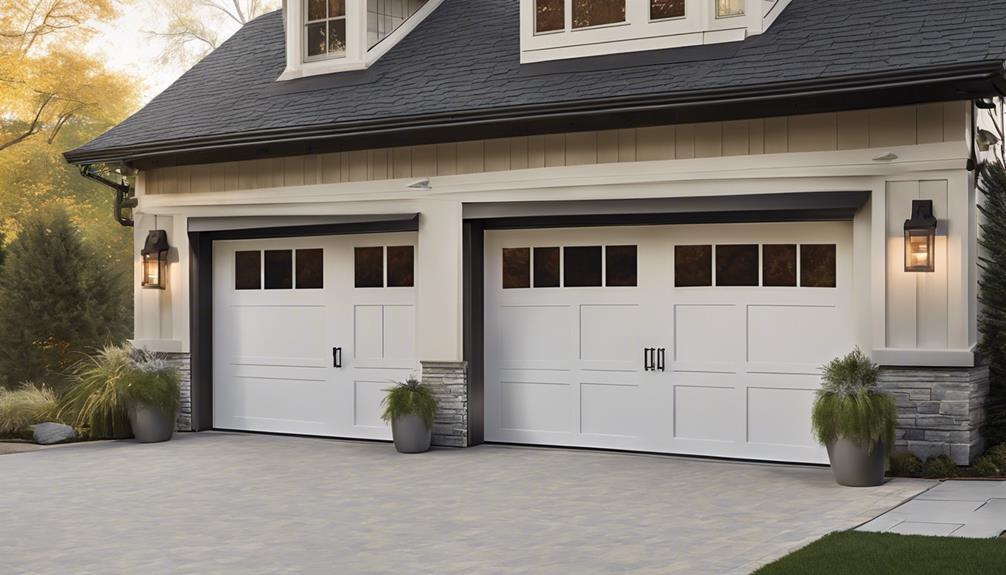
Craftsman garage door openers boast seamless compatibility with popular smart home systems like myQ, allowing for effortless integration into existing setups. This feature grants users the convenience of remotely controlling their garage door opener via smartphones or other smart devices, enhancing both accessibility and security.
With easy connectivity and smart home integration, Craftsman garage door openers offer a modern and efficient solution for homeowners looking to manage their garage door operations remotely.
Smart Home Integration
Craftsman Garage Door Openers seamlessly integrate with popular smart home systems, offering homeowners the convenience of remotely controlling their garage doors through smartphones or smart home devices.
This integration is made possible through the Craftsman myQ app, enabling users to monitor and operate their garage door opener from anywhere using their smartphones.
The integrated Wi-Fi and smartphone control features provide real-time alerts and monitoring capabilities, enhancing the security and accessibility of the garage door opener.
Ease of Connectivity
With seamless compatibility across a range of popular smart home systems, Craftsman Garage Door Openers ensure effortless connectivity and control for modern homeowners. The integration of Craftsman Garage Door Openers with smart home technology like the myQ Smart Belt Drive allows for convenient operation through smartphone apps via Wi-Fi connectivity.
This feature not only enhances accessibility but also provides remote monitoring capabilities, offering real-time alerts and ensuring the security of the home. Additionally, Craftsman Openers support voice control via virtual assistants such as Amazon Alexa and Google Assistant, further simplifying the user experience.
Energy Efficiency and Sustainability

Enhancing the efficiency of garage door openers is crucial for reducing energy consumption and promoting sustainability in household operations. Craftsman Garage Door Openers excel in energy efficiency and sustainability through various features:
- Energy-saving features: Craftsman Garage Door Openers are equipped with energy-saving components that help reduce electricity usage, lowering the overall carbon footprint.
- LED lights: Integrated LED lights not only provide bright illumination for the garage but also do so using energy-efficient technology, contributing to sustainability efforts.
- Backup battery: Offering backup battery options ensures that the garage door opener remains functional during power outages. This feature not only enhances convenience but also promotes energy efficiency by reducing reliance on continuous grid power.
- Optimized power usage: Craftsman Garage Door Openers leverage smart technology to optimize power consumption based on usage patterns. This intelligent operation further enhances energy efficiency, making the opener a standout choice for environmentally conscious users.
Durable Construction and Longevity
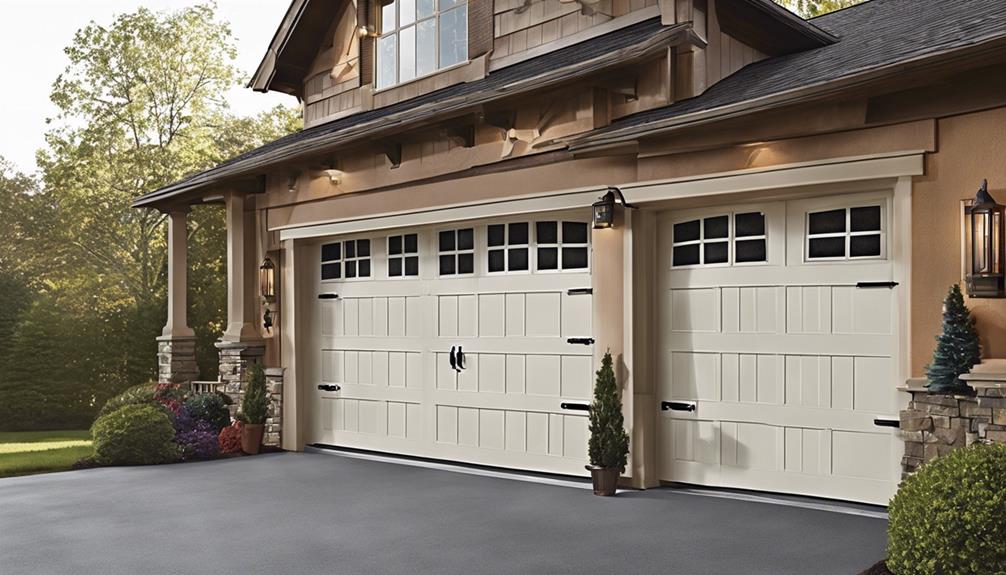
In our exploration of Craftsman Garage Door Openers, we shift our focus to the sturdy construction and longevity that define these exceptional home devices. Crafted with high-quality materials, Craftsman Garage Door Openers are engineered to last, offering durability that sets them apart in the market. The use of top-grade components ensures that these openers can withstand the rigors of daily use and endure harsh weather conditions without compromising on performance.
The durable construction of Craftsman Garage Door Openers guarantees a robust operation that homeowners can rely on. By investing in longevity through meticulous engineering and quality materials, Craftsman has created devices that not only function effectively but also stand the test of time. The longevity of these openers is a direct result of their superior construction, making them a trusted choice for those seeking reliability and durability in their garage door opener.
Customer Satisfaction and Reviews

Craftsman Garage Door Opener has garnered exceptional customer satisfaction ratings, reflecting praise for its durability and performance. Customers have expressed their satisfaction with the user-friendly interface of the Craftsman Garage Door Opener, finding the installation process straightforward and convenient.
The positive reviews also highlight the reliability of Craftsman's DieHard Garage Door Opener, emphasizing its seamless remote control functionality and integrated safety features. Moreover, the inclusion of a backup battery feature in Craftsman Garage Door Openers ensures operational continuity during power outages, enhancing customer satisfaction by providing peace of mind in unpredictable situations.
- Customers appreciate the user-friendly interface and ease of installation of Craftsman Garage Door Openers.
- The DieHard Garage Door Opener from Craftsman is lauded for its reliability and seamless remote control.
- Integrated safety features in Craftsman Garage Door Openers contribute to positive customer reviews.
- The backup battery feature enhances customer satisfaction by ensuring continued functionality even during power outages.
Value for Money and Warranty Coverage

Having established the exceptional customer satisfaction and reliability of Craftsman Garage Door Openers in previous discussions, it's crucial to highlight the unparalleled value for money and extensive warranty coverage offered by this renowned brand.
Craftsman Garage Door Openers provide exceptional value through their lifetime warranty on the motor and drive components, ensuring that customers receive long-lasting performance and quality. This warranty coverage not only offers peace of mind but also showcases Craftsman's commitment to durability and reliability.
Crafted with top-grade materials and exceptional craftsmanship, Craftsman Garage Door Openers stand out for their ability to withstand the test of time. Customers can rely on the lifetime warranty to address any motor or drive issues that may arise, further solidifying the brand's reputation for quality and longevity.
When seeking a garage door opener that offers exceptional value and extensive warranty coverage, Craftsman proves to be a standout choice for homeowners looking for innovation and peace of mind.
Frequently Asked Questions
Is Craftsman a Good Brand for Garage Door Opener?
Craftsman is a reliable brand for garage door openers. We've found Craftsman products to be durable, secure, and convenient.
The advanced safety features like Safety Reversing Sensors and smartphone control through Wi-Fi and the myQ App make Craftsman stand out. With a lifetime warranty on the motor and drive, Craftsman showcases its commitment to quality.
Infrared sensors and rolling code technology ensure a safe garage environment.
What Is the Difference Between Chamberlain and Craftsman Garage Door Opener?
When comparing Chamberlain and Craftsman garage door openers, the difference lies in their focus. Craftsman emphasizes simplicity and reliability, appealing to users seeking straightforward operation.
On the other hand, Chamberlain prioritizes innovation and technology, offering advanced features like battery backup and smart connectivity.
Ultimately, the choice between the two brands depends on individual preferences for design aesthetics and desired functionalities.
What Is the Life Expectancy of a Craftsman Garage Door Opener?
We've found that Craftsman Garage Door Openers boast an impressive life expectancy. These reliable units typically offer a lifetime warranty on their motor and drive components, showcasing their durability and longevity.
Crafted for attached garages, they're built to endure regular use. With proper maintenance, a Craftsman Garage Door Opener can last for many years, providing consistent performance and peace of mind.
Is Liftmaster and Craftsman the Same?
No, Liftmaster and Craftsman aren't the same. They both fall under the Chamberlain Group umbrella, offering distinct products targeting different markets. Liftmaster caters more to professional-grade garage door openers, while Craftsman focuses on quality tools for residential use.
Despite sharing some technology, they serve different segments. Understanding their features and warranties can help users choose the right garage door opener for their needs.
Conclusion
In conclusion, Craftsman Garage Door Openers are the epitome of excellence in the garage door industry. With their seamless operation, cutting-edge technology, and robust security features, Craftsman sets the standard for superior performance and reliability.
The innovative design and user-friendly features make operating your garage door a breeze, while the durable construction ensures longevity and peace of mind. Craftsmen Garage Door Openers truly paint a picture of effortless convenience and unmatched quality in every aspect of their design.
- About the Author
- Latest Posts
Introducing Ron, the home decor aficionado at ByRetreat, whose passion for creating beautiful and inviting spaces is at the heart of his work. With his deep knowledge of home decor and his innate sense of style, Ron brings a wealth of expertise and a keen eye for detail to the ByRetreat team.
Ron’s love for home decor goes beyond aesthetics; he understands that our surroundings play a significant role in our overall well-being and productivity. With this in mind, Ron is dedicated to transforming remote workspaces into havens of comfort, functionality, and beauty.
Garage Door Opener
Top 5 Prodrive Garage Door Opener Features You Need
Marrying innovation with safety, convenience, and smart technology, Prodrive garage door openers redefine the way you interact with your garage door.

When exploring the world of high-quality garage door openers, the Prodrive series shines bright with its innovative features.
Imagine a world where your garage door opener not only provides seamless integration but also prioritizes your safety and convenience.
The Prodrive lineup offers a blend of advanced security measures, smart technology compatibility, whisper-quiet operation, effortless remote control access, and a backup power option.
These elements hint at a game-changing experience that could revolutionize the way you interact with your garage door.
Key Takeaways
- Enhanced Security: Rolling Code Technology for constant access code changes, reducing unauthorized entry risks and setting new hacking prevention standards.
- Smart Home Integration: Seamless connection for remote monitoring, control via smartphones or voice assistants, virtual key granting, and instant notifications.
- Quiet Operation: Belt-drive system minimizes noise, ideal for bedrooms above the garage, ensuring efficient and reliable performance.
- Battery Backup: Ensures uninterrupted operation during power outages, maintaining security and accessibility, guaranteeing peace of mind in outage-prone areas.
Advanced Security Features
Enhancing security through innovative Rolling Code Technology, the Prodrive Garage Door Opener offers advanced features that prevent unauthorized access with each use. This cutting-edge technology ensures that the code used to open the garage door changes constantly, making it nearly impossible for hackers to intercept or duplicate the signal. By implementing Rolling Code Technology, the Prodrive Garage Door Opener significantly reduces the risk of unauthorized entry, enhancing both security and safety.
With this enhanced security feature, homeowners can enjoy peace of mind knowing that their garage is a secure environment. The risk of code duplication is eliminated, preventing intruders from accessing the garage through unauthorized means. By constantly changing the access code, the Prodrive Garage Door Opener sets a new standard in hacking prevention, offering users an unparalleled level of security.
Incorporating Rolling Code Technology into the Prodrive Garage Door Opener not only enhances security but also provides users with a reliable and secure solution for their garage access needs.
Smart Technology Integration
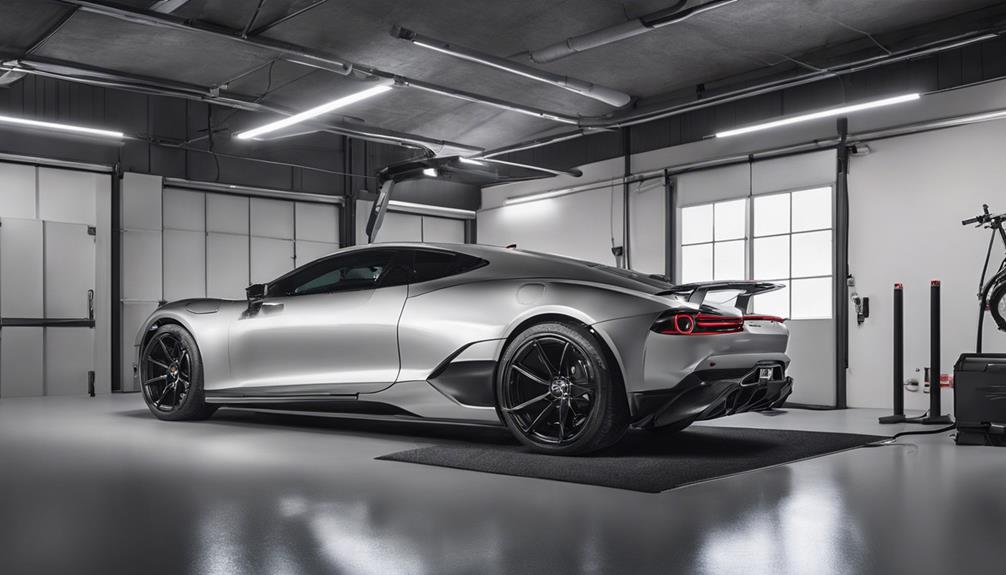
The seamless integration of smart home technology allows the Prodrive Garage Door Opener to provide remote operation and monitoring capabilities. With this smart garage door opener, you can control your garage door from anywhere, whether through a dedicated app on your smartphone or via voice assistants like Alexa or Google Assistant.
This level of access gives you the freedom to open or close your garage door in real-time, enhancing convenience and security. Additionally, receiving instant notifications about the status of your garage door ensures peace of mind, especially when you're away from home.
The Prodrive Garage Door Opener also offers the flexibility to grant temporary or permanent virtual keys to family members, friends, or service providers, enabling easy access without compromising security. Moreover, the ability to schedule automatic door operations based on your preferences adds another layer of convenience to your daily routine, making it a valuable addition to your smart home setup.
Quiet Operation Functionality
Incorporating a belt-drive system, the Prodrive Garage Door Opener ensures quiet and smooth operation, distinguishing it from traditional chain-driven models. The advanced technology of the belt-drive system results in quieter operation, significantly reducing noise levels compared to chain-driven openers.
This silent functionality creates a peaceful environment, making it perfect for homes with bedrooms above the garage. The Prodrive opener's smoother operation not only minimizes disturbance but also offers the convenience of a silent garage door opener.
Say goodbye to clunky, noisy garage door openers and embrace the tranquility of the Prodrive's quiet functionality. Whether you're coming home late at night or heading out early in the morning, the Prodrive opener ensures minimal disruption to household members while providing efficient and reliable performance.
Experience the liberation of a silent garage door opener with the Prodrive's innovative belt-drive system.
Easy Remote Access Control

With the Prodrive Garage Door Opener, conveniently control your garage door from anywhere using a smartphone or tablet. The easy installation process lets you set up remote access effortlessly.
Enjoy the freedom of managing your garage door with the touch of a button on your smartphone or tablet. Grant virtual keys to family members or service providers, allowing them temporary or permanent access with ease.
Receive instant notifications about your door's activity, keeping you informed in real-time. Integration with voice assistants like Amazon Alexa enables hands-free control for added convenience.
Monitor your garage door remotely with the Prodrive Opener, providing you with peace of mind wherever you are. The DC motor ensures efficient operation, while the power outlet feature adds versatility to your garage setup.
Embrace the liberation of controlling your garage door remotely with the Prodrive Garage Door Opener.
Battery Backup Capability
Transitioning from remote access control, the Prodrive Garage Door Opener impressively incorporates a battery backup capability ensuring uninterrupted operation during power outages. This vital feature guarantees that the garage door opener remains functional even when facing electrical disruptions.
With the battery backup, manual operation becomes unnecessary, maintaining both security and accessibility without compromising convenience. In regions where power outages are common, this Prodrive garage door opener feature provides peace of mind, knowing that the system will continue to function seamlessly.
Frequently Asked Questions
What Type of Garage Door Opener Drive Is Best?
When choosing a garage door opener drive, consider factors like noise level, maintenance needs, and door size.
Belt drives offer quiet operation, chain drives are durable but may be noisy, screw drives need minimal maintenance, and wall mounts save space.
Assess your priorities to determine the best fit for your needs.
What Brand of Garage Door Opener Is the Most Reliable?
When it comes to garage door openers, the most reliable brands are LiftMaster, Chamberlain, Craftsman, Genie, and Linear. These companies are well-known for their durable and dependable products.
Each brand offers a range of options to suit different needs, ensuring that you can find a reliable garage door opener that meets your specific requirements.
Trusting in these reputable brands can give you peace of mind when it comes to your garage door opener's reliability.
What Specs Do I Need for a Garage Door Opener?
When choosing a garage door opener, consider the horsepower required based on your door size and weight. Look for safety features like photo-eye sensors to prevent accidents.
Check compatibility with smart home systems for added convenience. Evaluate noise levels for quiet operation.
Ensure adequate security features like rolling code technology. These specs are crucial for a reliable and efficient garage door opener that meets your needs.
Who Makes Prodrive Garage Door Openers?
Prodrive garage door openers are made by Wayne Dalton, a leading company in the garage door industry known for quality and innovation. Their openers are designed for reliable and efficient operation on residential garage doors.
With various models offering different features, Wayne Dalton Prodrive openers are durable, high-performing, and incorporate advanced technology for modern garage door automation.
Homeowners seeking dependable garage door solutions often choose Prodrive openers for their quality, safety, and convenience.
Conclusion
In conclusion, the top 5 Prodrive Garage Door Opener features are like a sturdy shield guarding your home.
A smart assistant seamlessly integrates into your daily routine.
A silent ninja works in the shadows.
A remote control is at your fingertips.
And a reliable backup is available in times of need.
With these advanced features, your garage door opener system will operate smoothly, securely, and efficiently, providing you with peace of mind and convenience.
- About the Author
- Latest Posts
Introducing Ron, the home decor aficionado at ByRetreat, whose passion for creating beautiful and inviting spaces is at the heart of his work. With his deep knowledge of home decor and his innate sense of style, Ron brings a wealth of expertise and a keen eye for detail to the ByRetreat team.
Ron’s love for home decor goes beyond aesthetics; he understands that our surroundings play a significant role in our overall well-being and productivity. With this in mind, Ron is dedicated to transforming remote workspaces into havens of comfort, functionality, and beauty.
-

 Vetted14 hours ago
Vetted14 hours ago15 Best Plants to Thrive on the North Side of Your House – A Gardener's Guide
-

 Vetted1 week ago
Vetted1 week ago15 Best Boxwood Varieties for Thriving in Full Sunlight
-

 Vetted2 weeks ago
Vetted2 weeks ago15 Best Ways to Label Clothes for Nursing Home Residents – Stay Organized and Efficient
-

 Decor3 days ago
Decor3 days agoAre Home Decor Stores Profitable?
-

 Vetted1 week ago
Vetted1 week ago15 Best Dryer Vent Hoses to Keep Your Laundry Room Safe and Efficient
-
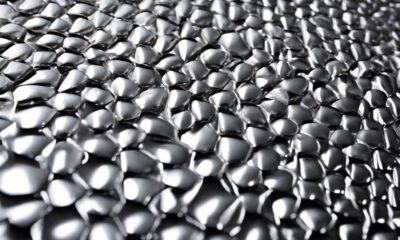
 Vetted1 week ago
Vetted1 week ago14 Best Cleaners for Aluminum Surfaces – Shine Bright Like a Diamond
-

 Vetted1 week ago
Vetted1 week ago15 Best Spider Sprays to Keep Your Home Arachnid-Free
-

 Vetted1 week ago
Vetted1 week ago15 Best Nightstand Charging Stations to Keep Your Devices Organized and Ready to Go










